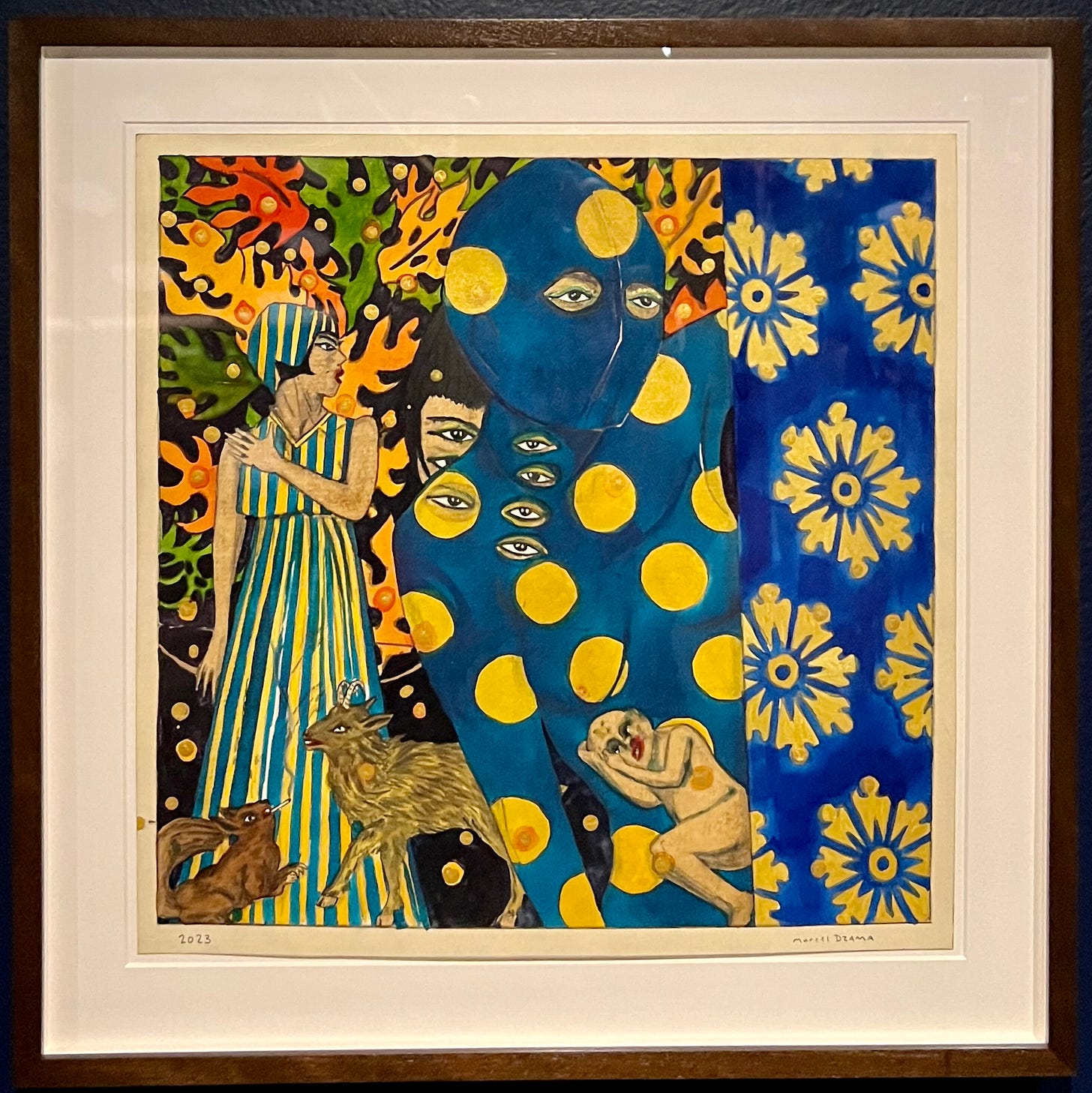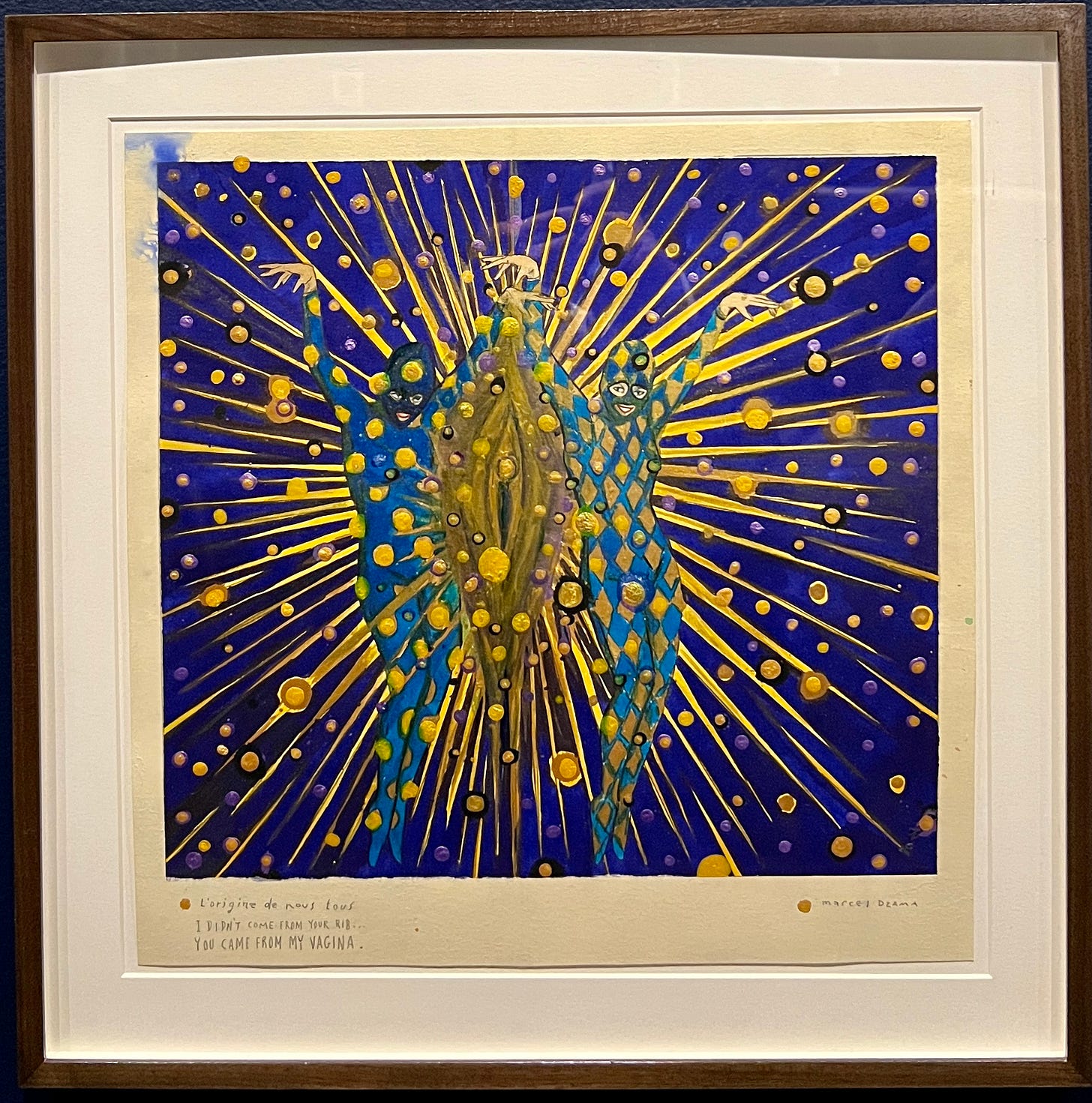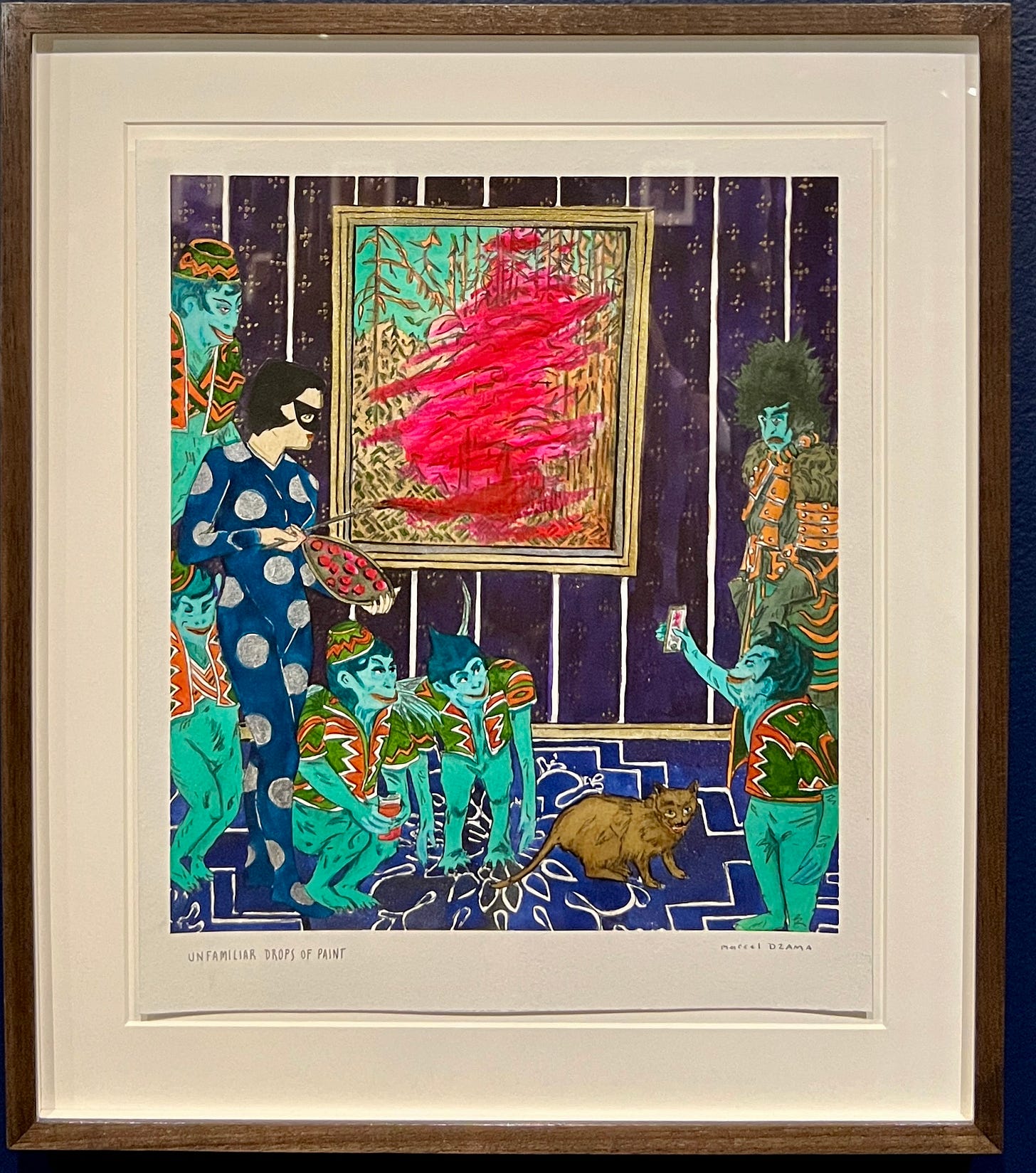Ghost of Canoe Lake, pearlescent acrylic, ink, watercolour, graphite on paper, 2023.
I’m almost as impressed with the people who encouraged Marcel Dzama early in his career as I am with him. It’s long ago now, but I remember not getting why I was being asked to look at his work. They were tiny doodle figures on a blank page, as I recall, and thoroughly off-topic from my point of view. I couldn’t find a way in and was mildly annoyed at being asked to think about them at all, as if my thoughts were being interrupted by nonsense. They seemed wholly unrelated to the preoccupations and techniques of the zeitgeist, and inscrutably private to boot, like a cultural non sequitur. Looking back now from a position of fondness for the work, that must have been the point.
Dzama represented a change of subject that must have appeared refreshing to the artists, programmers, dealers, writers and collectors who saw the kid’s merit and his promise that I did not. Perhaps they’d had enough of the artistic cud that I was still dutifully ruminating. Has someone written a good book on the sociology of talent scouting and encouragement? I would love to read it.
My own skills, such as they are, have nothing to do with ‘discovery.’ I come in after an artist’s work has started coursing through the cultural circulatory system, after the affirmative consensus initiated by others has done its job. I translate it for those who have not been following along, and I identify rich examples that carry a full load of the native magic, the works that can be productively talked about. To be candid, I’ve always felt a bit guilty about having the easier role.
But what initiates my eventual interest? Is the consensus of the scouts a kind of peer pressure? Or is it the seasoned work, matured by the encouragement? Can art even thrive without encouragement?
Speaking of rich examples, I would acquire The Ghost of Canoe Lake above. We’re told by the label that it was the first in Dzama’s marvellous new “Tom Thomson” series that opened on Friday in Kleinberg, next to a very good Thomson show. It has the right mix of Dzama’s comedy, darkness, quoting winks, nonchalance, anachronism and invention that I’ve come to enjoy.
I Don’t Come from Your Rib… You Came from My Vagina (or The Origin of Us All), pearlescent acrylic, ink, watercolour, graphite on paper, 2023.
Resembling illumination grotesques, showgirls in tights and matching balaclavas surround a giant gilded vulva. Is this a poster for Crystal Pite’s burlesque staging of Judy Chicago’s The Dinner Party? Gold rays of divine light that us Catholics know well from representations of the Holy Virgin—especially Our Lady of Guadalupe—spray out from the decoded mandorla. Mariology doesn’t call for golden plague buboes, though, let alone dancing girls in polka dots and harlequin lozenges. That’s on Dzama whose punning code shifts take us from religious iconography to feminist camp via existential dread, all of it sweetly lampooned.
This is the other work on paper that I would definitely want. Why not get both? His two-for-one iconography even extends to the colour, gorgeously pairing the sacred blue of aquamarine with the secular blue of cobalt. This isn’t blasphemy, though, you would have to be pretty humourless and out-of-touch to think so. Rather, it’s a fine example of Dzama’s signature light-hearted gravity about our self-cancelling species. He processes history as if revelation were mouldering in the cultural middens we call flea markets.
Maybe my favourite detail is the smudgy blue artefact in the upper-left margin, a little Brechtian test of the work’s power: ‘is it good enough to survive a splotch of messiness?’ Yes! How lovely to have kept it inside the matte. Dzama’s antiquarian frolics dissemble a wry and sometimes disturbing humour that pokes fun at our presumption of innocence in old things. We were never innocent, we were never great, all that still lies ahead.
Unfamiliar Drops of Paint on Closed Eyes, pearlescent acrylic, ink, watercolour, graphite on paper, 2023.
Not above commenting on current events, Dzama takes on a recent eco-prank by an earnest Canadian copycat who thought that Tom Thomson’s Northern River (1915) could use a lot more pink. Dzama shows us identically dressed circus monkeys mugging for the phone like iconoclasm tourists. A masked figure in a polka dot bodysuit, let’s call her the Allegory of the Righteous Painter, holds a pallet of only pink paint, evoking for me the monochromy of thought-police politics. A hapless Samurai stands guard in the background, looking equal parts sad and horrified.
Personal redemption seekers are not making any friends for the all-important cause of habitat hygiene by splashing toxic-coloured paint on an icon of Canadian nature conservation. On the contrary. Who, besides circus monkeys, would align themselves with vandals? Not a single tree was saved, but there will be more protective glass on paintings, while entering major museums is increasingly like taking an airplane.
Thomson is Canadian art’s most cherished naturalist. Son of a back-to-the-land nature buff, he was the mentee of his relative William Brodie, the man whose donation of 80K specimens—many likely collected by the teenaged Thomson—established the Royal Ontario Museum’s natural history collection. A conscientious objector, Thomson spent his last months living in his beloved forest to avoid deployment to the European front. Why not burn Rachel Carson in effigy while you’re at it.
This one-gallery show is among the more satisfying that I’ve seen by Dzama. The zany new video, To Live on the Moon (For Lorca), is a double homage to the Spanish martyr and to the almost certainly murdered Thomson. Filmmaker Guy Maddin, like me a Dzama fan, wrote a lively piece about it for the catalogue.
Dzama is a conservationist too, preserving old school art crafts to recontextualise images salvaged from the past—such as Méliès’ pock-marked moon grinning down on the show—to help make poetical sense of our black & white world. Less an archaeologist of spent sensibilities than a cryptographer of anachronisms, he’s someone who seems to get the (bigger) picture.






